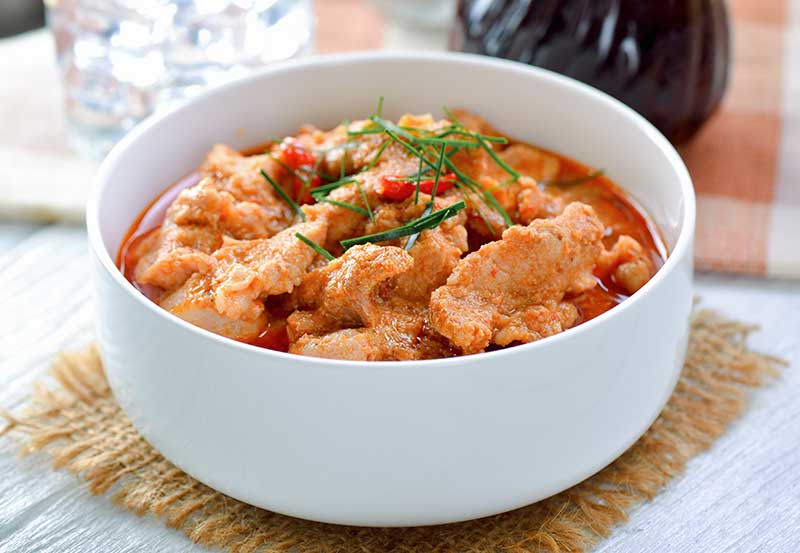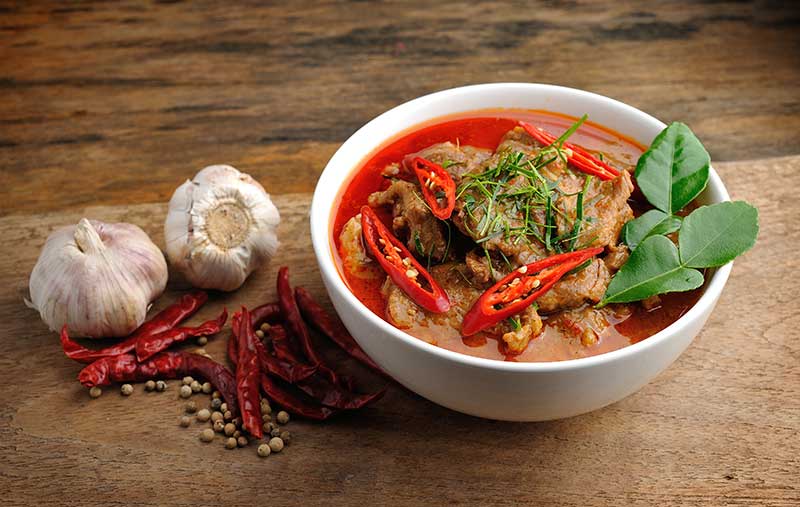Panang curry and Red curry are two of the most well-known Thai dishes, both of which feature the cuisine’s signature curries. These curries are delectable, but they are made with quite different flavors, ingredients, and techniques.
A Panang Curry:
Creamy and full in flavor, Panang curry is a Central Thai specialty. Penang, a Malay island close to the Thai mainland, is where the curry originated. Lemongrass, galangal, kaffir lime leaves, garlic, shallots, and dried red chilies are the foundation of a traditional Panang curry. To prepare the curry, combine the curry paste with the coconut milk, palm sugar, fish sauce, and your preferred protein and veggies, and cook the mixture. The combination of roasted peanuts and peanut butter lends a deep, nutty flavor to the final product. Panang curry is a fantastic alternative for those who are new to Thai food because it is typically less hot than other Thai curries.
Curcuma rosa:
In contrast, Northern Thailand is the birthplace of red curry, a hot and sour curry dish. Red chilies, garlic, lemongrass, and galangal are the backbone of a traditional red curry dish. Simmering the curry paste with coconut milk, fish sauce, and your preferred meat or vegetables yields a delicious curry. The red chilies give the meal its signature robust and spicy flavor. Simply by adjusting the amount of chilies used, the heat level of red curry may be modified to suit your preference.
Red curry and Panang curry are both commonly eaten with rice and accompanied by a sprinkling of fresh herbs like basil or cilantro. Pickled vegetables or a spicy dipping sauce made with fish sauce and chilies are frequent accompaniments to these curries in Thailand.
In conclusion, while both Panang curry and red curry are tasty Thai curries, they are distinctively different in terms of flavor, ingredients, and spice degree. Both the mild and nutty Panang curry and the fiery red curry offer a wonderful introduction to the exotic flavors of Thai cooking.
Here’s a recipe for Pork Panang Curry:
Ingredients:
- 1 lb. pork loin or tenderloin, sliced into thin strips
- 1 can (14 oz.) of coconut milk
- 3-4 tablespoons of Panang curry paste
- 2 tablespoons of palm sugar
- 2 tablespoons of fish sauce
- 1 tablespoon of vegetable oil
- 1/2 cup of roasted peanuts, roughly chopped
- 1 red bell pepper, sliced
- 1/2 cup of Thai basil leaves
- Cooked rice, for serving
Instructions:
- Heat the vegetable oil in a large pan or wok over medium heat.
- Add the Panang curry paste and stir-fry for 1-2 minutes until fragrant.
- Add the sliced pork and stir-fry for 2-3 minutes until browned.
- Add the sliced bell pepper and stir-fry for another 2-3 minutes until slightly softened.
- Add the coconut milk, palm sugar, and fish sauce and bring to a simmer.
- Reduce the heat to low and let the curry simmer for 10-15 minutes, stirring occasionally, until the pork is cooked through and the vegetables are tender.
- Add the chopped peanuts and Thai basil leaves to the curry and stir to combine.
- Serve the curry over cooked rice and garnish with extra peanuts and basil leaves if desired.
Enjoy your delicious Pork Panang Curry!

Tips to make a delicious Pork Panang Curry:
- Use high-quality ingredients: Use fresh ingredients whenever possible, especially the spices and herbs. This will help to enhance the flavor and aroma of the dish.
- Use the right cut of pork: Use pork loin or tenderloin, sliced thinly against the grain. This will ensure that the pork is tender and easy to chew.
- Don’t overcook the pork: Pork can easily become tough and chewy if it’s overcooked. Be sure to stir-fry the pork quickly over high heat, and then simmer it gently in the curry until it’s cooked through.
- Adjust the spice level: The spiciness of Panang curry can vary depending on the brand of curry paste you use. Taste the curry as it simmers, and adjust the spice level by adding more curry paste or less depending on your preference.
- Let the curry simmer: The longer you let the curry simmer, the more the flavors will meld together. Be sure to give it enough time to simmer on low heat to develop the full flavor.
- Use the right amount of coconut milk: The amount of coconut milk you use will depend on the thickness and consistency of the curry paste you’re using. Be sure to add enough coconut milk to make the curry creamy and rich, but not too soupy.
- Garnish with fresh herbs: Adding fresh herbs like Thai basil or cilantro to the finished curry will enhance the flavor and add a fresh pop of color to the dish.
By following these tips, you can make a delicious Pork Panang Curry that will be sure to impress your family and friends.

